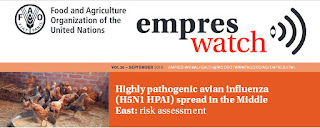#11,763
A little over a decade ago, when HPAI H5N1 was the only avian flu virus of genuine concern, the virus began its diaspora out of China and Southeast Asia into Europe, the Middle East, and Western Africa.
In a matter of 24 months we went from 15 countries reporting the virus, to more than 60.
Unexpectedly - and for reasons that aren't fully understood - by 2008 the virus began to give up some of its new found territories, but remained firmly entrenched in Indonesia, India, Bangladesh, and Egypt.
This decline began to reverse itself in 2014, and over the past two years we've seen a resurgence of HPAI H5N1 in Western Africa, Eastern Europe, and parts of the Middle East (see Another Busy Bird Flu Summer).
Perhaps most ominously, over the spring and summer we saw reports of large outbreaks in Iraq - the first time we've seen confirmed reports out of that nation in a decade.
Today, H5N1 is no longer the only novel flu on our radar (see CDC: IRAT Evaluation Of Novel Avian & Swine Flu Risks), and H5N1 continues to mutate and evolve, potentially increasing its threat to public health.
- In 2014, H5N1 picked up several key mutations in Egypt (see Eurosurveillance: Emergence Of A Novel Cluster of H5N1 Clade 2.2.1.2) which appear to have increased its transmissibility from poultry to humans, sparking the biggest human outbreak on record (see EID Dispatch: Increased Number Of Human H5N1 Infection – Egypt, 2014-15).
- H5N1 also returned to West Central Africa in 2014, and has become well entrenched, after an absence of 5 years (see EID Journal: HPAI A(H5N1) clade 2.3.2.1c In West Africa).
- And in 2015, in Novel H5N1 Reassortment Detected In Migratory Birds – China, we looked at the emergence and spread of clade 2.3.2.1c and made special note of its apparent neurotropic qualities.
All of which brings us to a recently published FAO/EMPRES Risk Assessment on the likelihood of further spread of HPAI H5N1 across the middle east.
Highly pathogenic avian influenza (H5N1 HPAI) spread in the Middle East: risk assessment
Summary
This risk assessment provides an estimate of the likelihood of introduction of H5N1 HPAI from recently infected countries (Lebanon and Iraq) to other countries in the Middle East region and neighbouring territories as a result of the movement of live poultry (both legal and illegal), poultry-related products and the migration of wild birds.
The preliminary assessment based on the available information and uncertainties associated indicate that the risk of introduction of H5N1 HPAI for each of the nine regional and neighbouring countries or territories varies and is as follows:
- High: Iran (Islamic Republic of), Israel, Jordan, the Syrian Arab Republic and Turkey
- Medium: Gaza Strip, Kuwait, Saudi Arabia and The West Bank
- Low: Armenia, Azerbaijan and Georgia
- Negligible: Cyprus
The situation in the region is of concern given the existing poultry populations at risk and the potential for spread between countries. Given the presence of civil unrest and active civil war in some countries of the region, investment in agriculture and livestock is reduced, including limitations to public veterinary services.
Underreporting of animal disease events is a significant challenge given the lack of reporting systems in those areas with ongoing conflict. It is therefore possible that, in addition to Iraq and Lebanon, the disease is already present in the Syrian Arab Republic. The cause of the recent incursions into the region is currently unknown but a combination of wild birds seeding infection and trade with neighbouring countries is likely.(Continue . . . )
Poultry and poultry-related trade and movements play an important role in national and cross-border spread. The overall risk for the region in terms of potential spread to uninfected countries ranges from negligible to high depending on the country with Iran (Islamic Republic of), Israel, Jordan, the Syrian Arab Republic and Turkey being at highest risk of incursion. The current H5N1 HPAI epizootic is expected to have a potential impact on food security, human health and poultry-dependent livelihoods in a region which is already suffering from political unrest and deteriorated public and animal health services.
You'll want to download and read the entire, data-rich 8 page risk assessment.
As discussed earlier this week, and from another FAO document (see FAO/EMPRES: H5N8 Clade 2.3.4.4 Detected Over Summer In Russia), the H5N8 virus has proven itself to be an excellent traveler as well, making its way to Europe, North America, and Taiwan within a year of emerging in South Korea.
Over the summer we've seen some evidence that H5N8 might threaten again this winter, and there are concerns what would happen if it should turn up in areas (like the Middle East or Western Africa) where H5N1 is already well established.
And of course, we continue to watch H7N9, H5N6 along with a longer list of (presumably) less concerning novel flu strains, for signs of geographic spread of enhanced transmission.
